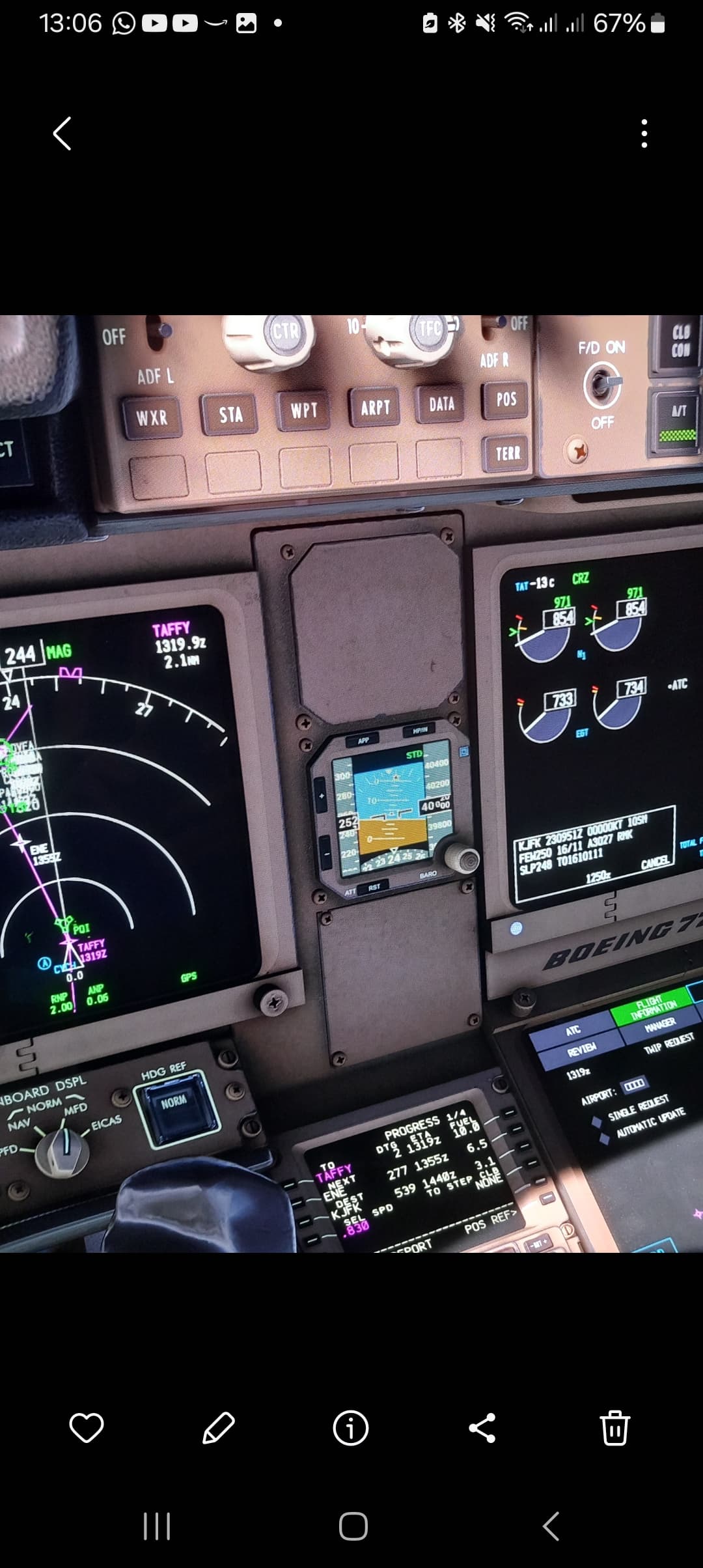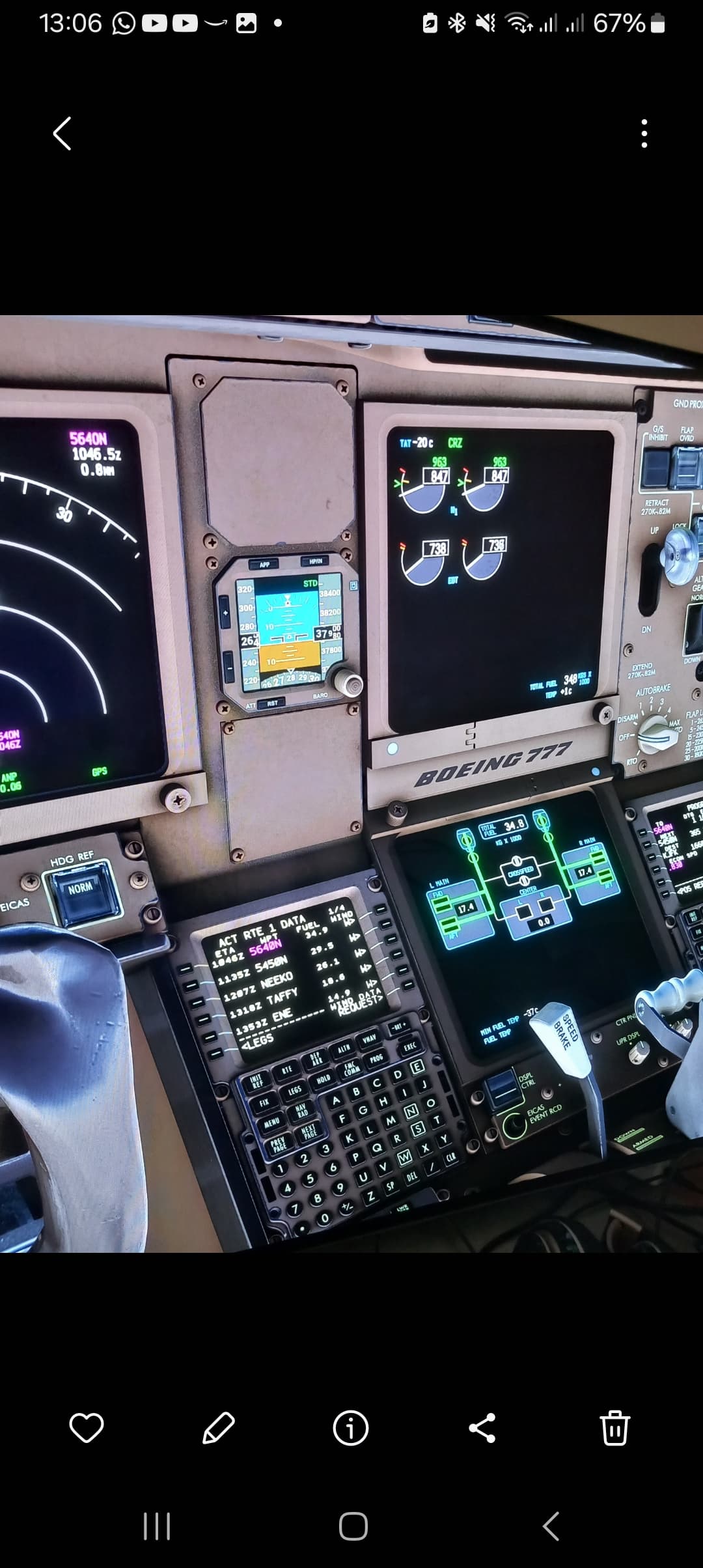Interesting question: In the PMDG Universal Flight Tablet documentation, under settings, it shows “REAL-WORLD” set on the screenshot. I didn’t see any text explaining why this setting or any other settings like “SIM”. Would leave it as is unless they get back to us to change it.
My flights have been with SIM weather in the tablet, i am pretty sure it was on that by default.
This is used only for the METAR display on the tablet nothing more
Interesting. I just booted the 777 and my EFT also defaults to “SIM” so just leave it there then?
The advantage is that what you see and your aircraft experiences matches the data.
Mathijs Kok
PMDG.
Just completed the longest flight I have made to date in the 77W, KEWR-KDEN, 3:21 in the air. FWIW fuel burn, SAT, & TAT all tracked closely to my flight plan in SimBrief and the FMC. The most fuel burn was off that I noted was 1,500 lbs over plan shortly before ToD. TAT was within 1 or 2 degrees of forecast and SAT varied from 0 to 6 degrees colder than forecast, but was within 3 degrees of forecast most of the flight. While certainly not long haul LOL, there was no trend towards running low on fuel on this (or any previous) flight. So far I have only flown the 77W over the continental US - about a dozen hours over 8 flights - so perhaps there is something to the trans-Atlantic hypothesis above mentioned. Hope folks figure that out soon so the longer flights can complete as expected. Cheers!
If there is, it’s certainly inconsistent. I’ve made several transatlantic flights ranging from ~7 hours real-time (KBNA - EGLL eastbound), 9 hours realtime (EGLL - KBNA westbound) and up to 12 hours (LSZH - KSFO) time-compressed down to less than 4 hours, and my fuel has never been more than a few hundred pounds off at any given waypoint or my destination. In each case I didn’t check every single waypoint, but I spot checked every 30 - 45 minutes or so, confirming fuel remaining, predicted vs. actual winds and predicted v. actual temps. Of course, if winds or temps are consistently wrong, then predicted fuel burn definitely won’t match the actual flight.
Are you guys using live weather/realtime.
Yes, just about always when flying turbines on a SimBrief flight plan. I actually plan my flights around the actual weather I wish to fly a certain route in, for example, to take advantage of a jet stream or brisk tailwind. Or crosswinds when flying westbound to save time. Most of the time I prefer good weather so I can sightsee along the way, then again, sometimes I do fly in bad weather to keep my skills up LOL. For GA flying, I will sometimes use the weather defaults for short or fun flights, but not with SimBrief.
Personally, I fly with the sim’s live weather, nearly 100% of the time.
Yes i like to keep it as real as i can , so live weather for me. I live close too and work at EGKK so i do like to fly out of there it is a shame Gatwick does not look a bit better in the sim (well on xbox anyway) PC looks a lot better from what i have seen. Anyway i digress, i am planning on another T7 flight tomorrow and will be keeping an eye on temps and fuel…really enjoy flying the T7.
It’s not just transatlantic. I had the insufficient fuel issue with a flight from KEWR to KSFO. Barely made it to KLAS.
But, I’ve made other flights of same or longer distances without issue — including transatlantic. (All with live weather enabled.)
@GimbalAxis I’ve never had one fuel issue in the 737-800/900 and have many hours in both.
As I wrote before, if you select the DAL version of the OFP in SimBrief you get the TAT for waypoints, we are still rather sure the issue is caused by that, so checking if the sim does what SimBrief predicted is possible.
Do note that we saw some instances of people trying to climb to flight levels that were hardly possible, and this caused the fuel issue. The 777 is not an aircraft that loves to cruise really high (compared to other aircraft).
Not sure if this makes any odds but with the fuel loaded from SB i had the insufficient fuel warning on the gate before engine start.
So i have made my first EGLL - KJFK:
ZFW: 188407 Kg
Block fuel: 66 314 Kg
TOW: 254 721 Kg
Fuel Factor on SB: i use this time P10
Fuel planning on SB: i use EASA (because it is a long haul range / said by a330 driver in video)
FL360 (first step)
FMS reserve fuel: 10,6T
EFOB at EGLL: 15.6 T
I made flight steps requested on FMC.
After using auto sim rate x 8, the fuel began to drop quickly. I know that auto sim rate is not the problem.
At 100Nm of the TOD, the EFOB at KJFK is around 2000Kg, so i added fuel sadly…
Here are the temps at 5640N and TAFFY. It was after done an auto sim rate so i don’t know if they are still correct after an acceleration.
When do you use LRC on vnav page (long range cruise)?
Thank you
What was your SAT temp at TAFFY (second page on PROG)
I should have to look the SAT, i was concentrated on TAT. ![]()
Before auto sim rate, the SAT were good with data SB.
But i didn’t look after acceleration…
I got that on my most recent eastbound transatlantic flight (KBNA - EGLL) until I went through the preflight workflows and loaded in the en route winds. Since was heading eastbound (with generally prevailing tailwinds most of the route), those winds made a tremendous difference. I went from an estimated 8 thousands pounds of landing fuel to an estimated 18,500. When I landed I had something like 18,700 pounds, I think.
I used to be an. FAA qualified aircraft dispatcher.
It was planning and monitoring the long haul flights that kept me awake at night - because a couple of tons for mum was never likely to save the day, like it does flying short haul. Believe me we would be watching predicted vs actual burns like hawks, especially on transoceanic segments and if weather started to go down in a region, possibly taking out your planned alternate too…
Short haul was much easier in comparison.
Ant the beancounters would have you and the captain fill out a report if you loaded p10 (like we can in the sim).
With the t7 on an longhaul route its worthwhile make sure the SB plan is run close to departure time to get latest forecasts into the system.
Ive also noticed that I get good actual vs predicted results at up to X4 compression but on two experiments on transatlantic sector KFDW- EGLL, I found that an increase to x8 or x16 the actual burn seems to become significantly greater than planned, so personally I think something goes a bit awry somewhere when the acceleration rate gets too high.
Blame your diispatcher if you like - but at least Id be sitting on thr ground in an office - I’d most likely be the one calling you up and telling you to take an en-route diversion to tank up before my hair turned white. We were all smokers in those days and we did the fuel planning manually from tables….sigh.
We have never seen that and never had any repeatable report of that. Not saying it does not happen, but it would be strange as it simply runs the same calculations, just faster.
Mathijs Kok
PMDG


